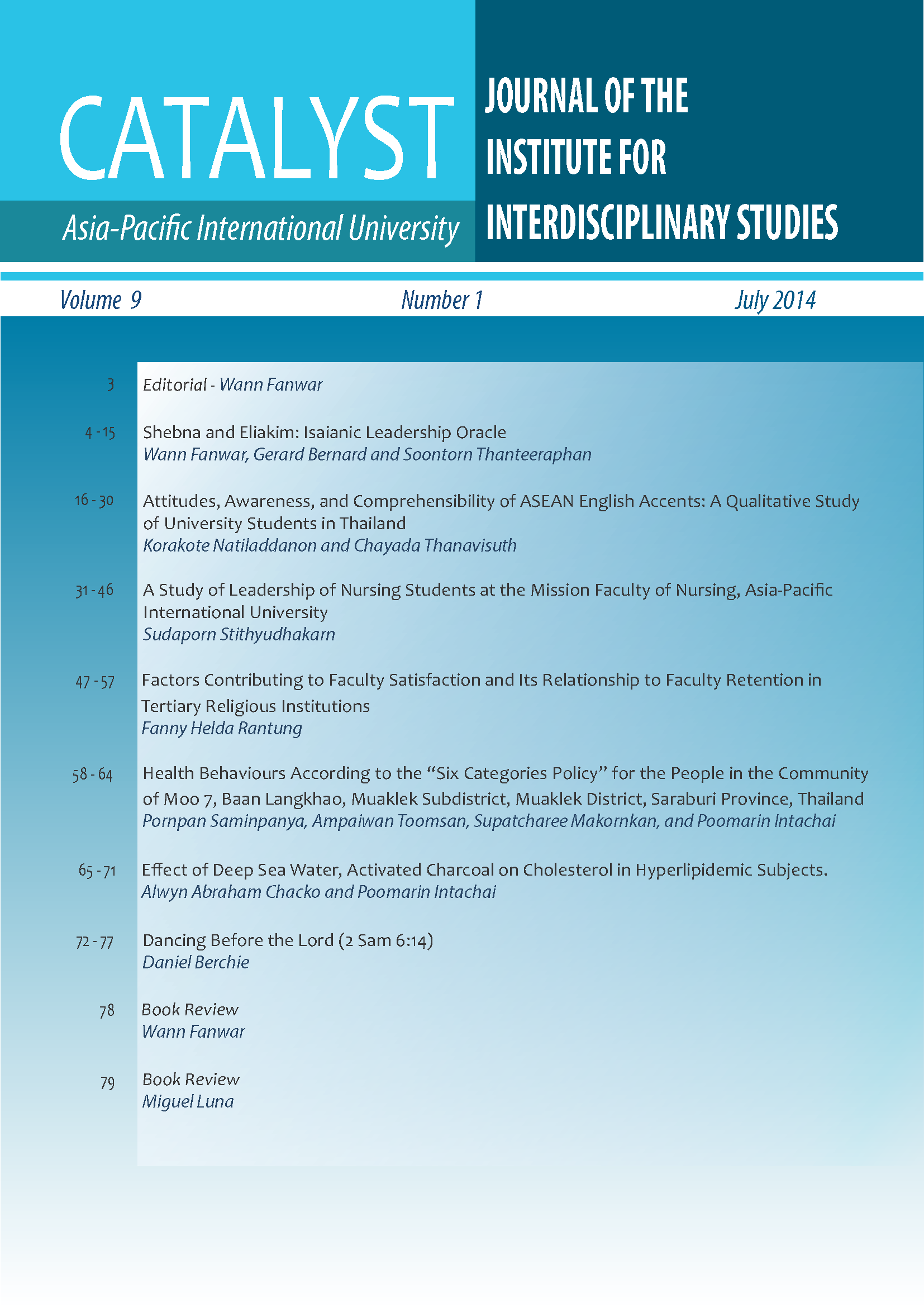Understanding the Causes of Anxiety and Coping Strategies of Student- Teachers during Their Internship: A Phenomenological Study
Main Article Content
Abstract
This study was intended to fulfill two purposes: 1) to identify the causes of student-teachers’ anxiety, and 2) to discover the coping strategies they employed during their internship program. The participants of this study were eight student-teachers who did their internship in the 2013-2014 academic year as required by their undergraduate program in education at a faith-based International University. The phenomenological approach was employed to understand their lived experiences in relation to anxiety and coping strategies during their teaching internship. Data were collected through individual meetings, group forums, observations and individual interviews. The study discovered that student-teachers’ anxiety was caused by various factors which can be grouped into three categories: preparation, classroom management and relationship. This study also identified four categories of coping mechanism employed by the student-teachers: adaptation, preparation, attitude and relationship. The findings of this study give cooperating teachers and internship supervisor insight into the experience of the eight student-teachers.
Article Details

This work is licensed under a Creative Commons Attribution-NonCommercial-NoDerivatives 4.0 International License.
Copyright: Asia-Pacific International University reserve exclusive rights to publish, reproduce and distribute the manuscript and all contents therein.
References
Bawcom, L. (2005). Preventing stress and burn-out. Modern English Teacher, 14 (2), 51.
Bogdan, R. C. & Biklen, S. K., (1992). Qualitative research for education: An introduction to theory and methods. Boston:
Allyn and Bacon. Bress, P., (2006). Beating stress, Modern English Teacher, 15(3), 9-10.
Cheung, H. Y., & Hui, S. K. F., (2011). Teaching anxiety amongst Hong Kong and Shanghai in-service teachers: The impact of traits anxiety and self esteem. The Asia-Pacific Education Researcher, 20(2), 395-409.
Costa, A. L. & Kallick, B., (2000). Getting into the habit of reflection. Educational Leadership, April, 60-62.
Creswell, J. W. (2013). Qualitative Inquiry & Research Design: Choosing among five approaches (3rd Ed.). Thousand Oaks, CA: SAGE.
Creswell, J. W., (2010). Mapping the Developing Landscape of Mixed Methods Research. Sage Handbook of Mixed Methods in Social & Behavioral Research, Tashakkori, A. and Teddlie, C. (Eds), California, 45-68.
DeMoulin, D. F., (1993). Efficacy and educational effectiveness. In J. R. Hoyle & D.M. Estes (Eds.), NCPEA: In a new voice (155-167). Lancaster, PA: Technomic Publishing Company, Inc.
Gardner, L. E., & Leak, G. K. (1994). Characteristics and correlates of teaching anxiety among college psychology teachers. Teaching of Psychology, 21(1), 28-32.
Goyette, R., Dore, R., & Dion, E., (2000). Pupils’ misbehaviors and the reactions and causal attributions of physical education student teachers: A sequential analysis. Journal of Teaching in Physical Education, 20, 3–14.
Horwitz, E. K., Tallon, M. & Luo, H. (2009). Foreign language anxiety. In J. C. Cassady (ed.), Anxiety in schools: The causes, consequences, and solutions for academic anxieties. New York: Peter Lang.
Ingersoll, R. M., & Smith, T. M. (2003). The wrong solution to the teacher shortage. Educational Leadership, 60(8), 30–33.
Keavney, G., & Sinclair, K. E., (1978). Teacher concern and teacher anxiety: A neglected topic of classroom research. Review of Educational research, 48(2), 273-290.
Klanrit, P. & Sroinam, R. (Nov. 2012). EFL Teacher’s anxiety in using English in teaching in the language classroom. International Journal of Social Science and Humanity, 2(6).
Leedy, P. D., (1997). Practical Research: Planning and Design (6th ed.). Upper Saddle River, NJ: Prentice-Hall, Inc.
Martin, R. A., & Yoder, E. P., (1985).Clinical teaching analysis: A procedure for supervising teachers. The Journal of the American Association of Teacher Educators in Agriculture, 26(4), 16-21, 33.
Merc, A., (2004). Reflections of pre-service EFL teachers throughout their teaching practicum. What has been good? What has gone wrong? What has changed? (Unpublished master’s thesis). Anadolu University, Eskisehir.
Montgmery, B. (2000). The student and cooperating teacher relationship. Journal of Family and Consumer Sciences Education,18(2), 7-15.
Norris, R. J., Larke, A., Jr., & Briers, G.E. (1990). Selection of student teaching centers and cooperating teachers in agriculture and expectations of teacher educators regarding these components of a teacher education program: A national study.
Journal of agricultural Education, 31(1), 58-63. Numrich, C., (1996). On becoming a language teacher: Insights from diary studies. TESOL Quarterly, 30(1), 131-151.
Oral, B., (2012). Student teachers’ classroom management anxiety: A study on behavior management and teaching management. Journal of Applied Social Psychology, 42(12), 2901-2916.
Randall, M. & Thornton, B., (2001), Advising and Supporting Teachers. Cambridge University Press, Cambridge, 99-100.
Sammephet, B. & Wanphet, P., (2013). Pre-service teachers’ anxiety and anxiety management during the first encounter with students in EFL classroom. Journal of Education and Practice. 4(2), 78-87.
Schon, D. A., (1983). The Reflective Practitioner. New York: Basic Books, Inc.
Shank, G. D., (2006). Qualitative Research: A Personal Skills Approach. Upper Saddle River, New Jersey: Pearson.
Takahashi, H., (2014). Non-native English-speaking teachers’ self-perceived language proficiency levels, anxieties, and learning strategies. International Journal of Christianity and English Language Teaching, 1, 24-44. ISSN 2334-1866
Wilson, V., (2002). Feeling the strain: An overview of the literature on teachers’ stress. The Scottish Council for Research in Education.


